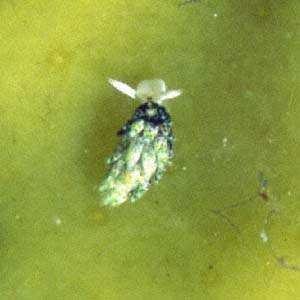
Costasiella sp. 1.
Order: SACOGLOSSA
Superfamily: LIMAPONTIOIDEA
Family: Costasiellidae
DISTRIBUTION
Reported here from Indonesia and Guam.
PHOTO
Tukang Besi Islands, Sulawesi, Indonesia. PHOTO: Adam Powell.
See messages from Indonesia and Guam below.
Authorship detailsRudman, W.B., 1999 (March 20) Costasiella sp. 1. [In] Sea Slug Forum. Australian Museum, Sydney. Available from http://www.seaslugforum.net/find/costsp1
Related messages
Costasiella sp. 1.? from Okinawa.
August 14, 2007
From: Yasuhiro Shamoto
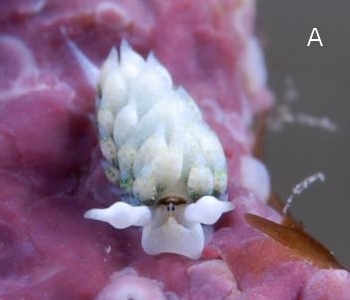
Dear Dr. Rudman,
I found an animal with swelling on the rhinophores in Kerama Is. Okinawa. I first thought that it was Costasiella sp. 1. but the swelling give me doubts. Also my friends have found similar animals.
A. Locality: Zamami Island, Kerama Is, Okinawa, Japan, Pacific Ocean,
7 March 2007. Length: approx 5 mm, Depth: 8 m. Habitat: coral reef
Water temperature: 21 degrees. Photo: Yasuhiro Shamoto
B. Locality: Okinawa Is, Japan, Pacific Ocean, 30 March 2007. Length: approx 3 mm. Depth: 4 m. Habitat: coral reef. Water temperature: 21 degrees. Photo: Masanori Ishikawa
C. Locality: Zamami Island, Kerama Is, Okinawa, Japan, Pacific Ocean, 20 March 2007. Length: approximate 2 mm. Depth: 18 m. Habitat: coral reef
Water temperature: 21 degrees. Photo: Yukari Sato
I would be grateful for any comment
Yours sincerely
Yasuhiro Shamoto
yasunao515@cyber.ocn.ne.jp
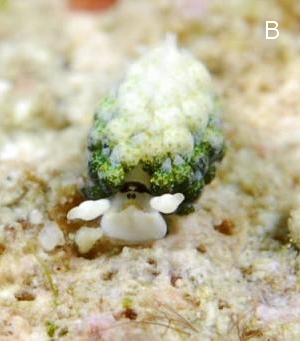
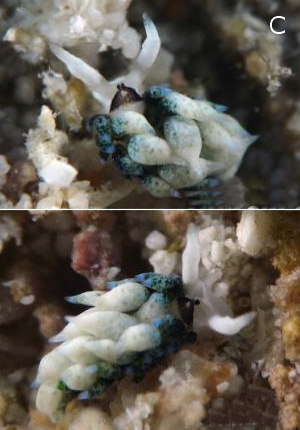
Dear Yasu,
I am not quite sure why these animals all have swellings on the rhinophores like this. Some species of sacoglossans use the cerata and rhinophores as secondary pumps but that is a rhythmic swelling and narrowing not a permanent swelling. Perhaps Kathie Jensen has a comment. I would consider them to be Costasiella sp. 1.
Best wishes,
Bill Rudman
Re: Costasiella from Hawaii
November 17, 2003
From: Clay Carlson
Bill,
This Costasiella is probably another example of Costasiella sp.1.
Clay
ccarlson@kuentos.guam.net
Thanks Clay,
I think you're right. It looks quite like the one in Cory Pittman's photo from Hawaii
Best wishes
Bill Rudman
Costasiella from Hawaii
November 16, 2003
From: Dan Barshis
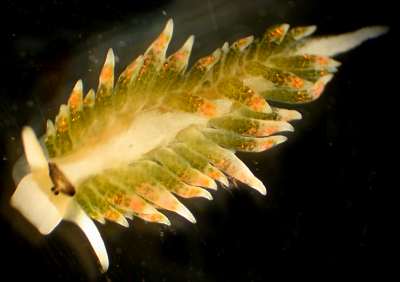
Is this an aeolid [Berghia or Spurilla perhaps?
It was collected on the south shore of Oahu, Hawaii, at nearshore depths (<1m). The area was typically a sandy, mud bottom. The specimen is approximately 4-5mm long. We found it in our aquarium with our other collections from the site approximately 1 week later. We were actively collecting Plakobranchus ocellatus and some Chelidonura spp. along with some algae. As seen in the photo the orangish-golden color has a metallic, sparkle. The green color could be attributed to symbiotic algae in the cerata. Any information regarding this species would be much appreciated as we were unable to determine its identity from the guide on this website.
Thanks for the help,
Dan Barshis
barshis@hawaii.edu
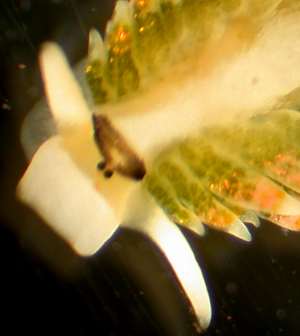
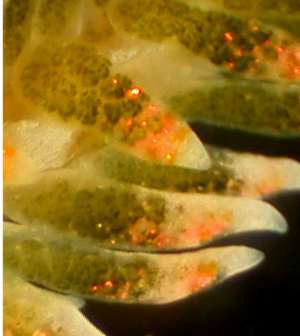
Note added 17 Nov 2003: this is Costasiella sp. 1. See Clay Carlson's message.
Dear Dan,
Although it certainly looks like an aeolid nudibranch it is in fact a sacoglossan that looks like an aeolid. Sacoglossans are all herbivores so the green aggregations in the cerata are likely to be clusters of chloroplasts they have obtained from their algal food. I am not sure if species of Costasiella retain the chloroplasts alive. The genus Costasiella is easily identified by the pair of eyes situated close together in the dorsal midline. No other opisthobranch has eyes like this, so even without knowing the differences between sacoglossans and aeolids, it is possible to confidently identify these animals to a genus. However we still have a lot of problems identifying individual species so unless Kathe Jensen can give us a species name I will call this Costasiella sp. 4
Best wishes
Bill Rudman
Costasiella from Okinawa
April 28, 2002
From: Atsushi Ono
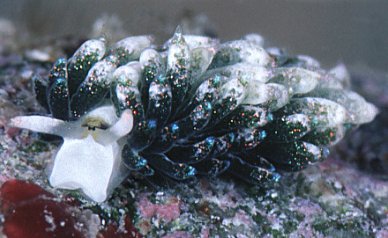
Dear Bill,
Here is an image of Costasiella sp. 1. This is the same species as Costasiella sp. P. 44. in my book.
This was a big individual ... 12mm long if my memory serves me right. I caught this one on the rope of a fish preserve at Kerama Is. in Okinawa.
Sincerely,
Atsushi Ono
ononini@cosmos.ne.jp
Ono, A., 2002 (Apr 28) Costasiella from Okinawa. [Message in] Sea Slug Forum. Australian Museum, Sydney. Available from http://www.seaslugforum.net/find/6227Thanks Atsushi,
Bill Rudman
Re: Costasiella sp. 1 from Hawaii
February 7, 2002
From: Kathe R. Jensen
Dear Bill,
Every time I see messages about species of Indo-Pacific Costasiella on the Forum I get a bad conscience. I have 4 or 5 species of Costasiella from Singapore, which I was supposed to have described with Jon Sigurdsson, and I have 2 species from Guam and 2 from Phuket, one of which may be the same, and also one from India, which may be identical to one of the Singaporean species. The reason my Costasiella - paper never even got started is that this awful paper by Ichikawa appeared. In this paper she describes 6 species of Costasiella based on photos and serial sections. There are so many characters not mentioned in these descriptions that it is impossible to compare these species with others. I had hoped to have time in Vienna to look at the holotype sections, but I had to go back to Thailand for teaching. So Costasiella remains one of my bad consciences. But it is nice to see that apparently one species has a wide distribution. Judging from the pictures in Ichikawa's paper it is not one of her species.
Reference: Ichikawa, M. 1993. Saccoglossa (Opisthobranchia) from the Ryukyu Islands.
Greetings,
Kathe
jensen@ait.ac.th
Jensen, K.R., 2002 (Feb 7) Re: Costasiella sp. 1 from Hawaii. [Message in] Sea Slug Forum. Australian Museum, Sydney. Available from http://www.seaslugforum.net/find/6186Dear Kathe,
I mentioned the Ichikawa paper in the first message that was sent to the Forum on this species. It seems many species of Costasiella have quite a distinctive colour pattern so perhaps not all is lost. I guess the problem is that without using anatomical characters as well it is difficult to know whether Ichikawa's species are colour varieties or distinct species. For example the black 'collar' or 'spectacles' in Costasiella sp. 1 seems very distinctive but it is possible that Ichikawa's Costasiella iridophora is based on a specimen without these black markings.
I guess the only way forward is to describe your species as fully as possible and if necessary, name them as new species. If they are later shown to be synonyms of one of Ichikawa's species that is a small price to pay for having your information available to us all.
Cheers,
Bill Rudman
Costasiella sp. 1 from Hawaii
February 6, 2002
From: Cory Pittman
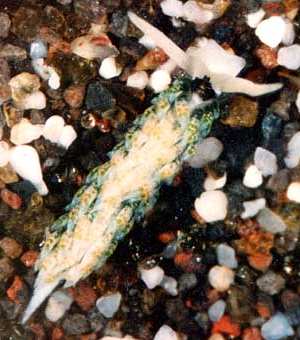
Dear Bill,
This probably extends the range of Costasiella sp. 1 to Hawaii. The animal in the photo was collected at Hekili Point, Maui on June 1, 1991. It was in an algae wash taken at a depth of less than one meter in a semi-protected back-reef habitat. It was 4.5 mm in length. I've only seen the species twice. The other was an even smaller animal collected in a similar habitat at the same site on Oct. 13, 2000.
Best wishes,
Cory
Cory@cet.com
Pittman, C., 2002 (Feb 6) Costasiella sp. 1 from Hawaii. [Message in] Sea Slug Forum. Australian Museum, Sydney. Available from http://www.seaslugforum.net/find/6176Thanks Cory,
It certainly looks the same.
Bill Rudman
Costasiella sp. 1. from South Africa
February 5, 2002
From: Valda Fraser
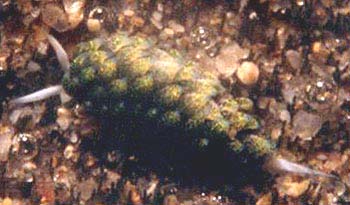
Dear Bill,
Lots of these small nudibranchs live in particular parts of the pools that I often snorkel in. They like very shallow water where bubbles seem to form at low tide. Can you help with identification?
Locality: Pumula, south coast KwaZulu-Natal, South Africa, intertidal zone
Date: December 2001
Size: From about 5 - 12 mm
Regards
Valda Fraser
valdafraser@mweb.co.za
Fraser,V., 2002 (Feb 5) Costasiella sp. 1. from South Africa. [Message in] Sea Slug Forum. Australian Museum, Sydney. Available from http://www.seaslugforum.net/find/5844Dear Valda,
This is Costasiella sp. 1. From your description, this is one of a number of species of sacoglossan from around the world which live right 'at the edge' where the tide pools are high, and often quite hot, and only have their water changed at the highest of high tides. Cynthia Trowbridge studied a New Zealand ecological equivalent, Ercolania felina and aptly described it as 'life at the edge'.
Best wishes,
Bill Rudman.
Costasiella sp. 1 from South Africa
February 5, 2002
From: Lindsay Warren
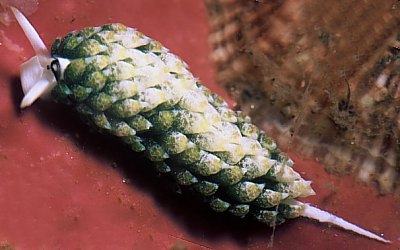
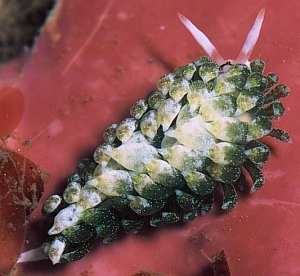
Dear Bill
I thought you might be interested in a couple of shots of Costasiella sp. 1 which Valda Fraser finds on a regular basis in the intertidal rockpools at Pumula, KwaZulu Natal, South Africa. We found two 'groups' of them (11 and 15) in different parts of the pool at 2pm on 18 December 2001 on low growing filamentous algae. Sizes: Upper Photo: 11 mm, Lower Photo: 8 mm. As you can see the cerata are quite a bit darker than the specimens found in SE Sulawesi, Indonesia but I think they are the same species.
What do you reckon?
Photos: Lindsay Warren.
All the best
Lindsay
alldcl@compuserve.com
Warren, L., 2002 (Feb 5) Costasiella sp. 1 from South Africa. [Message in] Sea Slug Forum. Australian Museum, Sydney. Available from http://www.seaslugforum.net/find/6078Thanks Lindsay,
Valda recently told me you were visiting South Africa. I'm glad you obviously had a successful trip. Valda has recently snt me a photo of this species so I'll post both messages together. It certainly looks very similar to Costasiella sp. 1 which would suggest this species has a wide distribution throughout the Indo-West Pacific, with records in the Forum from South Africa to Guam.
Best wishes,
Bill Rudman
Costasiella sp. 1 from Sulawesi
July 28, 2000
From: Lindsay Warren
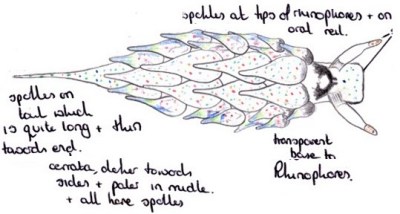
Dear Bill
This Costasiella was found by Rich Smith on 21 June 1999 at a depth of 7.1m on rubble on an underwater pinnacle next to Pulau Hoga [Tukang Besi Archipelago, SE Sulawesi, Indonesia - Operation Wallacea]. Size: 3 mm.
Although similar to Costasiella sp. 1 he found in 1998 and which you posted on the Forum, there are several differences which may or may not be significant. The first is that the rhinophores of this specimen narrowed down towards the end and were covered in colourful speckles whereas the 1998 specimen had rhinophores of the same diameter along their length and were entirely white. The second difference is the black marking between and behind the rhinophores [see sketch at bottom left]. A third difference is that there were colourful specklings on the tail in this specimen and none on the 1998 one [see sketch at upper right] . Illustrations: Rich Smith, Photo: Lindsay Warren.
Incidentally I noticed that the photo from 1998 was credited to me whereas it should in fact be credited to Adam Powell.
Do you think it is the same species or a different one?
All the best
Lindsay Warren
alldcl@compuserve.com
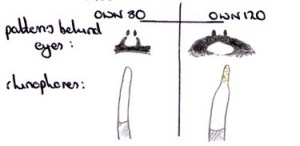
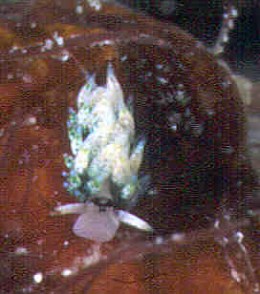
Dear Lindsay,
I think we are in trouble if those differences are significant. I am sure that your two animals fit within the normal range of variation to be found in that species. Clay Carlson & Patty Jo Hoff's animal is also probably the same species, which would suggest the black markings between the rhinophores are a quite important character. It is possible that some of the more brilliant iridescent speckling becomes less noticeable as the animals grow and/or become more pigmented.
I will change the photo credit.
Best wishes,
Bill Rudman.
Re: Colour in Costasiella
March 25, 1999
From: Clay Carlson & Patty Jo Hoff
Bill,
The green in the scan of the underside of the animal is a bit darker than on the slide. We have no idea what this one feeds on so don't know what affects the colour on the cerata. We have photos of specimens with almost all green cerata and then others with varying amounts of white.
Clay Carlson
Patty Jo Hoff
Guam
clay.carlson@kuentos.guam.net
Clay Carlson & Patty Jo Hoff, 1999 (Mar 25) Re: Colour in Costasiella. [Message in] Sea Slug Forum. Australian Museum, Sydney. Available from http://www.seaslugforum.net/find/725Chemical defence in Costasiella
March 24, 1999
From: Bill Rudman
While looking at literature on Costasiella I came across the following abstract on chemical defence in an unnamed species of Costasiella from India. I thought this was of particular interest following Clay Carlson & Patty Jo Hoff's comment that most species of Costasiella in Guam feed on Avrainvillea. I quote part of the abstract below:
Chemical Defence of the specialist ascoglossan Costasiella sp. from the Indian Coast.
"... The present study records the distribution of the herbivorous ascoglossan molluscs, Cosatasiella sp. feeding exclusively on the chemically defended green algae Avrainvillea erecta. This algae contains avrainvilleol, a brominated diphenyl methane derivative which deters herbivores ... known palatable algae coated with the diethyl ether extracts of both Avrainvillea and Costasiella deterred herbivorous fishes significantly. ... Either the whole organism or the egg mass of Costasiella was avoided by carnivorous fish.
Padmakumar, K. 1996. Chemical Defence of the specialist ascoglossan Costasiella sp. from the Indian Coast. Proceedings of the 6th Workshop of the Tropical Marine Mollusc Programme (TMMP). Phuket Marine Biological Center Special Publication, 16: 326.
Bill Rudman.
Rudman, W.B., 1999 (Mar 24). Comment on Chemical defence in Costasiella by Bill Rudman. [Message in] Sea Slug Forum. Australian Museum, Sydney. Available from http://www.seaslugforum.net/find/716Costasiella sp. 1. from Guam
March 23, 1999
From: C Carlson & P.J. Hoff
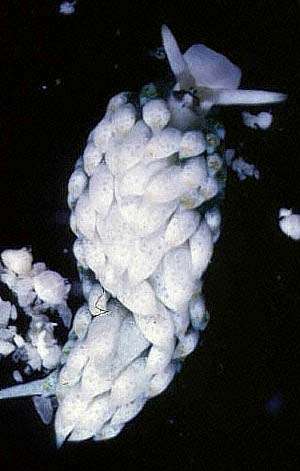
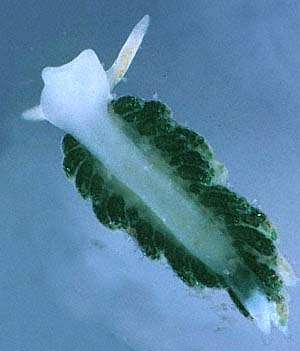
Bill,
We don't have a name on this one but thought we might show a slightly whiter color form. There are two animals in the scan so the length may be misleading. This is an interesting Costasiella since it seems to be found almost everywhere except on Avrainvilla -- the common host for most Costasiella. We quite often find it in areas where there are haminoeid egg masses though haven't observed them feeding. Aside from Guam, we have this species from Pagan & Saipan in the Northern Marianas as well as Yap and Palau
UPPER PHOTO: 2 animals, about 3.5mm; Guam, Cocos Lagoon, 1m, October 1971
LOWER PHOTO: ventral view showing foot; 3.0mm; Guam, Toguon Bay, 8m; 23 March 1989.
Clay Carlson & Patty Jo Hoff
Merizo,
Guam
clay.carlson@kuentos.guam.net
Carlson, C. & Hoff, P.J., 1999 (Mar 23) Costasiella sp. 1. from Guam. [Message in] Sea Slug Forum. Australian Museum, Sydney. Available from http://www.seaslugforum.net/find/712Dear Clay & Patty Jo,
Thanks for the photos. I am curious about the dark green in the ventral photo. Is the white pigmentation a skin colour on the dorsal surface or does this species change from green to white depending on diet?
Bill Rudman.
Costasiella sp from Sulawesi
March 20, 1999
From: Lindsay Warren

Bill,
Here is another mystery from Tukang Besi Islands, [Sulawesi, Indonesia - Operation Wallacea ]
Length: 3 mm. Simple rhinophores, white with transparent tip and base. Black collar around 'neck' behind rhinophores. White oral veil. Distinct eye spots. Cerata had black base with "most incredible dazzling colours on cerata - primarily pinks and greens like tinsel. Cerata nearer the foot were shorter and generally primarily black with green tip.
Underside shows translucent edge to foot with just green and pink sparkle."
Notum never visible due to clustered cerata. Tail white and very thin. Found at a depth of 5 m in between Sarcophyton soft coral on rubble covered in algal growths. This was referred to as the 'Christmas Tree Nudibranch'!
Photo: Adam Powell.
All the best
Lindsay
100014.2112@compuserve.com
Warren, L., 1999 (Mar 20) Costasiella sp from Sulawesi. [Message in] Sea Slug Forum. Australian Museum, Sydney. Available from http://www.seaslugforum.net/find/692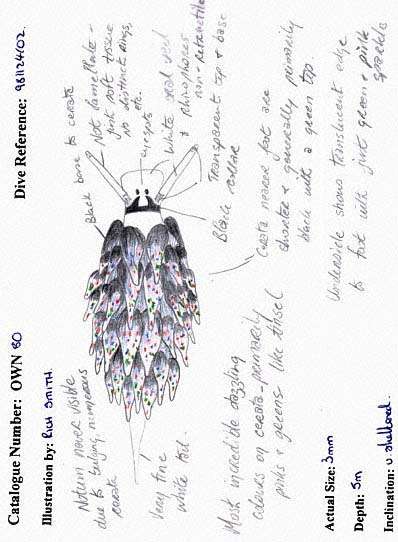
Dear Lindsay,
My first thought was that it looks like a species of Cuthona, but the apparent lack of oral tentacles on the oral veil suggests it is not. Thanks for the field notes and sketches which confirm their absence. I think it is a sacoglossan and the eyes set closely together are characteristic of the genus Costasiella. Ichikawa (1993) described quite a few species of Costasiella from the Ryukyu Islands and one of these, Costasiella iridophora is similarly speckled with iridescent specks. However your animal has a very characteristic black "collar" behind the eyes which I have not seen described for a species of this genus so it is probably a new species.
Bill Rudman.
Reference:
Ichikawa, M. (1993) Saccoglossa (Opisthobranchia) from the Ryukyu Islands. Publications of the Seto Marine Biological Laboratory, 36: 119-139.
